Getting a veg box delivered is a great way to support local farmers and ensure you eat a changing selection of fresh vegetables.
Which is the best veg box for you?
- 5 Nov 2024
Posted in Produce & Products
Checkout using your account
Checkout as a new customer
Creating an account has many benefits:
Getting a veg box delivered is a great way to support local farmers and ensure you eat a changing selection of fresh vegetables.
Posted in Produce & Products
No visit to Cornwall is complete without tasting its iconic pasty. Originating from the mining era, the story goes that these portable lunches were crafted by housewives for their miner husbands and children. The traditional pasty is filled with potato, swede, onion, and beef, wrapped in a D-shaped pastry. Miners would hold the thick crust while eating, discarding it after to avoid contamination from their tin or copper-dusted fingers.
According to the Cornish Pasty Association, these recipes have been cherished and passed down through generations. Today, only pasties made in Cornwall can be called "Cornish pasties," ensuring authenticity. Modern variations include meat, vegetarian, and vegan options.
Our ones come from Ann’s Pasties from The Lizard. Ann has now been joined by her son Fergus – a champion gig rower. Their pasties have a lovely flaky pastry and are packed full of local meat and veg. They produce a classic traditional steak, as well as a delicious cheese pasty, and wholemeal vegan. The Working Boat blog, recommends Ann’s for their pastry.
Other ones we would recommend include Philp’s Bakery from Hayle, Gear Farm for delicious organic pasties and plenty of filing, or St Agnes Bakery for their gluten free options.
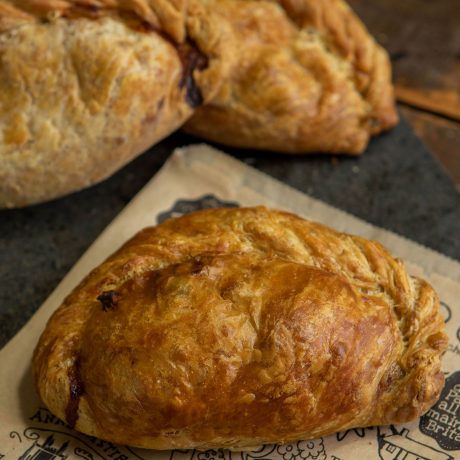
Cornwall, surrounded by the clear waters of the Atlantic, is a paradise for fish & seafood lovers. From traditional fish and chips to gourmet dishes like crab, lobster, and mussels, there's plenty to savour.
Lucy from Cornwall Food & Farming notes: “There are countless places to eat in Cornwall, all a stone's throw from the sea, meaning you’re always getting fresh fish and seafood on the menu. Mackerel Sky is a great place for lunch - it’s just a stone’s throw from Newlyn Harbour, one of the UK’s biggest fishing ports. Try some Newlyn Crab – it’s the best crab meat you’ll ever have.”
If you want to get a taste of Cornwall at home, then you can order fresh fish and seafood to be delivered to you at home. Fresh fish including monkfish perfect for barbecues, hake steaks, and delicate flat fish are readily available and of course Cornwall’s famous crabs and lobsters caught in pots along the rock coast by the small fishing boats.
If you want to get a regular supply of seasonal fresh fish then a Seasonal Fish Box is a great way to go. You get the freshest fish being landed in Cornish harbours delivered to your door – and experience the best in fresh fish and seafood at home.
Treat yourself to a hearty Cornish breakfast or brunch. The traditional hogs pudding replaces black pudding in a Cornish fry-up. Hogs pudding is a white sausage made using pork, breadcrumbs, and herbs, served sliced and fried. Paired with the finest eggs from properly free range hens, delicious sourdough, rare breed sausages and flaky pastries, a Cornish breakfast is a delight not to be missed!
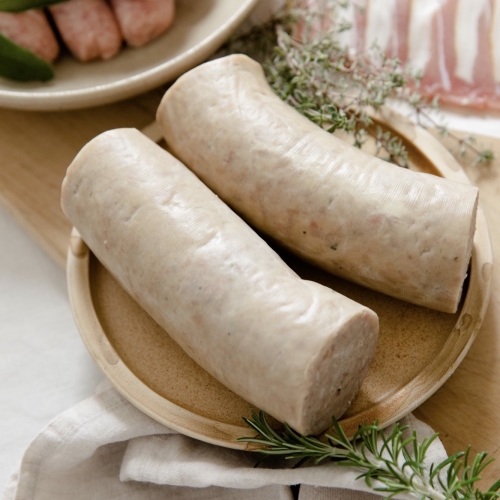
This unique pie, filled with white sauce, eggs, potato, and pilchards, features the heads of pilchards poking through the pastry. Originating from Mousehole, it commemorates fisherman Tom Bowcock, who braved a storm to provide food for the village and save them from starvation. Stargazy Pie is still enjoyed as a festive dish in Mousehole on Tom Bowcock’s Eve celebrated on 23rd December. Cornish pilchards.
Pilchard have long been a mainstay of the Cornish fishing community. Huge shoals of them would be sighted and The “Huer” would cry out to alert the fishing boats. A seine net would be set around the shoal and drawn to the coast where the whole community would get involved packing the pilchards tightly in barrels with salt to preserve them. Today pilchards are more often referred to as Cornish Sardines. Wonderful on the barbecue and then simply serviced with a squeeze of lemon and twist of black pepper.
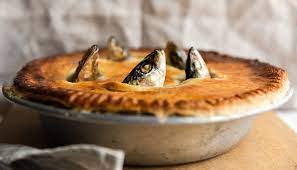
Cheese lovers will adore Cornish Yarg, a cheese wrapped in nettles handpicked from Cornish hedgerows. This gives the cheese a unique flavour while removing the nettle sting. Yarg is made from a 300-year-old recipe discovered in an attic. Distinctive nettle-wrapped Yarg was first produced in the 1980s when Bodmin Moor farmer Alan Gray found a 17th-century recipe in his attic and named it after himself (spell it backwards!). It now comes in original Cornish and Wild Garlic varieties. Cornish Yarg is a semi-hard, cow's milk cheese known for its unique appearance. When wrapped in nettles they impart a slightly earthy, mushroom-like flavor and a striking green and white rind. The interior of Cornish Yarg is creamy and mild, with a slightly crumbly texture and a gentle tang.
Cornish Blue won World Champion Cheese in 2010. This mild creamy blue is a welcome surprise for those who find stilton too harsh. This cheese pairs perfectly with tomato chutney and a hunk of sourdough bread.
There are over 60 different cheeses made in Cornwall. From soft goats’ cheeses, to rind washed farmhouse cheeses and continental style cheese such as gouda. This means there is a cheese made in Cornwall for every occasion.
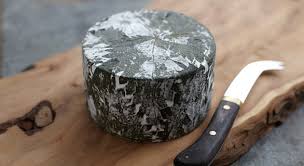
Saffron cake, rich and bright yellow from saffron, are a sweet treat iconic to Cornwall. Enjoy sliced plain or with butter. It can be eaten fresh or lightly toasted slathered with butter.
Hevva Cake, a traditional Cornish fruit cake, is made with self-raising flour, butter, mixed dried fruit, sugar, and milk. Hevva cake is finished with a criss-cross pattern representing fishing nets. It is a delicious tea-time treat made with currants and spices.
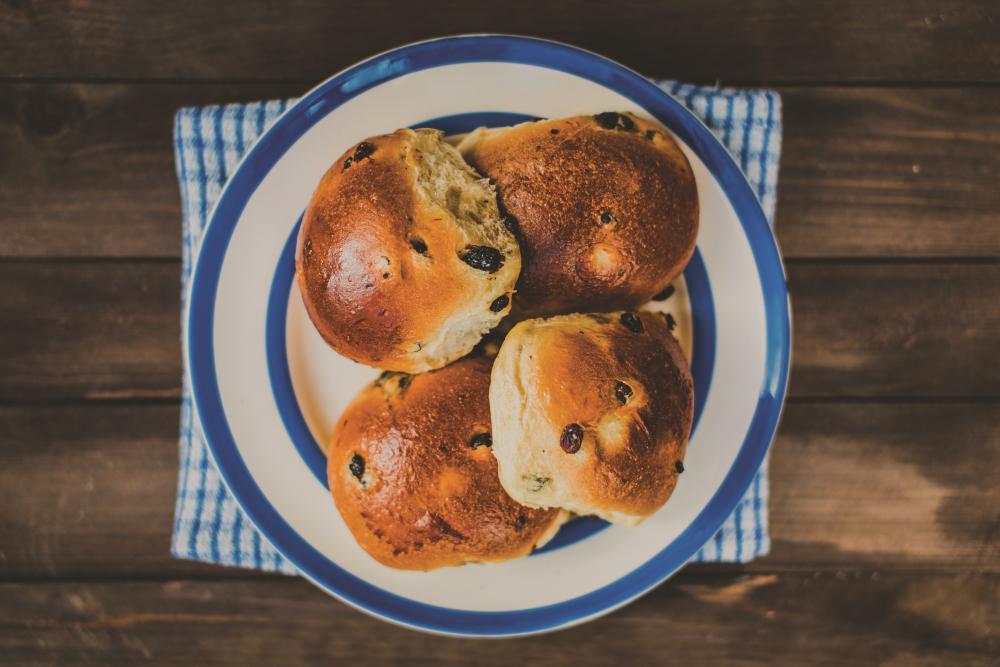
A Cornish cream tea is a delightful, sweet treat. The main difference between Devon and Cornish cream tea is the order of jam and clotted cream. In Cornwall, jam is spread first, followed by clotted cream. We recommend Boddington’s strawberry jam, a rich fruit ladened jam which pairs perfectly with the thick clotted cream dolloped on top. For a twist why not try Thunder & Lightening? This pairs golden syrup or honey with clotted cream spread on to scones of Cornish splits.
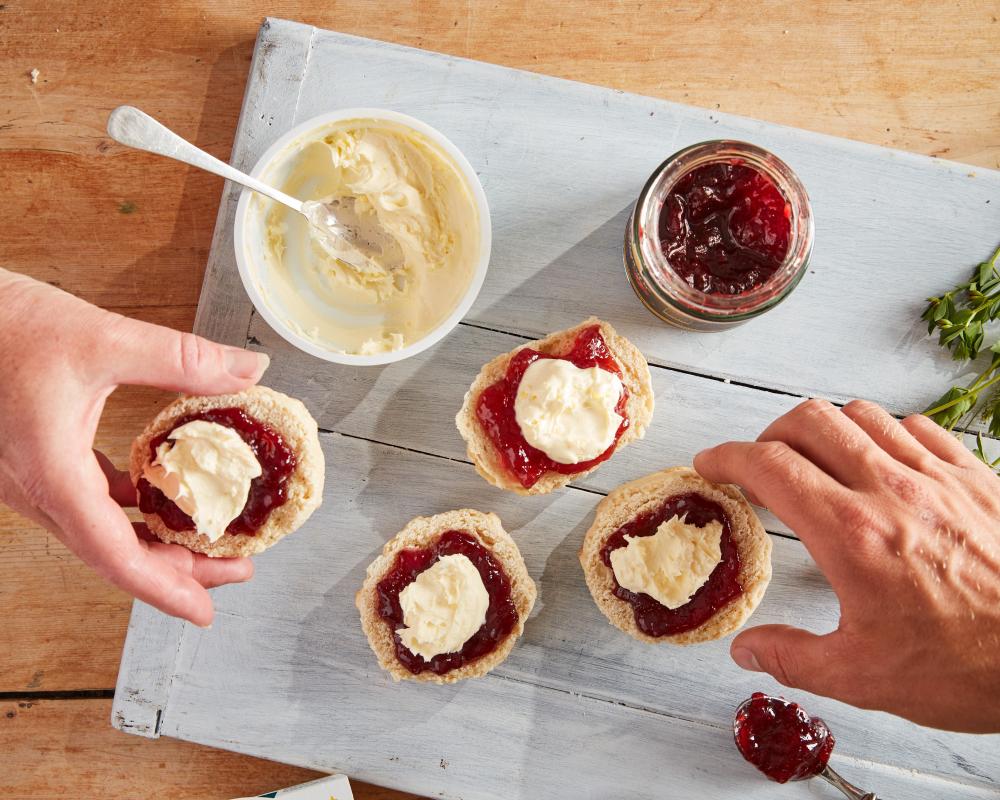
Cornwall’s warm mild climate and sloping south facing lands means it has developed a burgeoning wine growing industry. Pioneers of the Cornish wine industry, Camel Valley Vineyard produce the highly regarded Camel Valley Brut which is served at Royal weddings, in Michelin starred restaurants, and in BA First Class amongst other prestigious places.
There is now a fine selection of red, rose and white wines produced on vineyards across the County. Cornish winemakers have won awards at both National and International Wine Awards. Polgoon’s Pinot Noir Rose pairs perfectly with Cornish seafood and their Rondo Red is delicious with a Cornish cheeseboard.
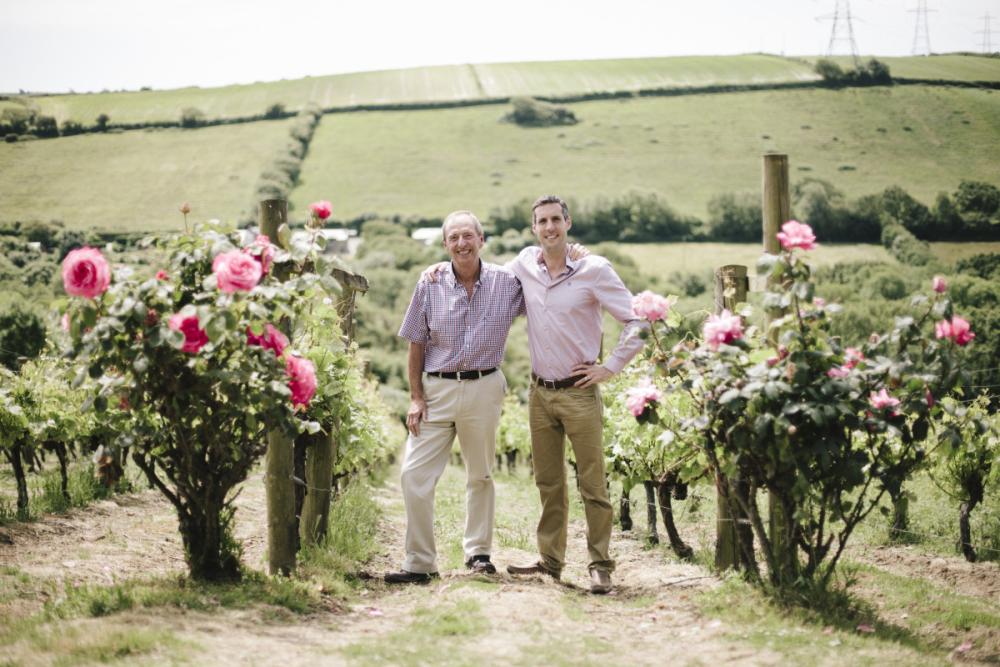
Cornwall is home to some of the best ice cream in the UK, thanks to its many dairy farms and fantastic grass. The smooth, creamy texture is achieved using local clotted cream. Cornish dairy is excellent due to our mild climate where the grass grows nearly all year round! The milk produced has a much higher fat content than elsewhere meaning our cream is richer.
There are several dairy companies producing their own ice cream. Callestick and Roskillys are both long established ice cream makers milking their own herds.
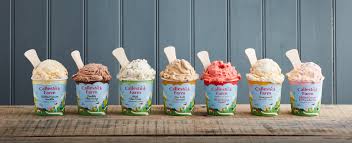
Cornwall is home to many cider makers from tiny operations pressing their home-grown apples to well established businesses enjoyed across the country such as Healey’s Rattler.
One of our favourites is the very special Fowey Valley Vintage Cider which is made in the champagne style. This bubbly cider is perfect served in place of prosecco on a hot summers afternoon.
The gin industry has really taken off in recent years with a wide range of artisinal makers in the County. From the well know Tarquin's to smaller artisan makers such as Loveday there are gins made with a range of botanicals giving distinctive flavours of the seashore.
Cornwall is a dream destination for foodies, with its thriving market of local food producers, farm shops, and food fairs. There are wonderful restaurants and bistros in almost every town and village showcasing local food cooked by highly regarded chefs, often boasting unique views and stunning locations. Cornish food can be enjoyed wherever you are in the UK with fast deliveries from the County to your door. Many producers offer a mail order service but a great way to buy products from a variety of Co9rnish producers is to put your own box together from The Cornish Food Box Company. From the freshest fish and seafood to the finest wines, cheeses, and regional delicacies.
Posted in Cornish Guide and Produce & Products
Cornwall is renown for making fabulous cheese many of which have won prestigous awards, including two World Champions! There are now over 60 different types of cheese produced in the country and includes a wide range of types from extra mature gouda to fresh goats cheese. Our guide to choosing your Cornish cheese gives you in depth information about a whole selection of Cornish cheeses.
Cheese-making dates back several millennia, possibly as a means of creating a longer-lasting product from milk - not only from cows but also goats, sheep and even buffalo. The base liquid is curdled, separated, and pressed; the flavour and texture can be influenced by many factors: age, temperature, environment and added seasonings.
As a whole food cheese is a great source of calcium, essential healthy fats and protein. The best cheese to eat is made from grass-fed dairy as it contains much higher levels of omega-6, omega-3 fatty acids and the healthy fats which are great for preventing obesity, heart disease and reducing inflammation. Grass-fed dairy is also far better for the environment and animal welfare.
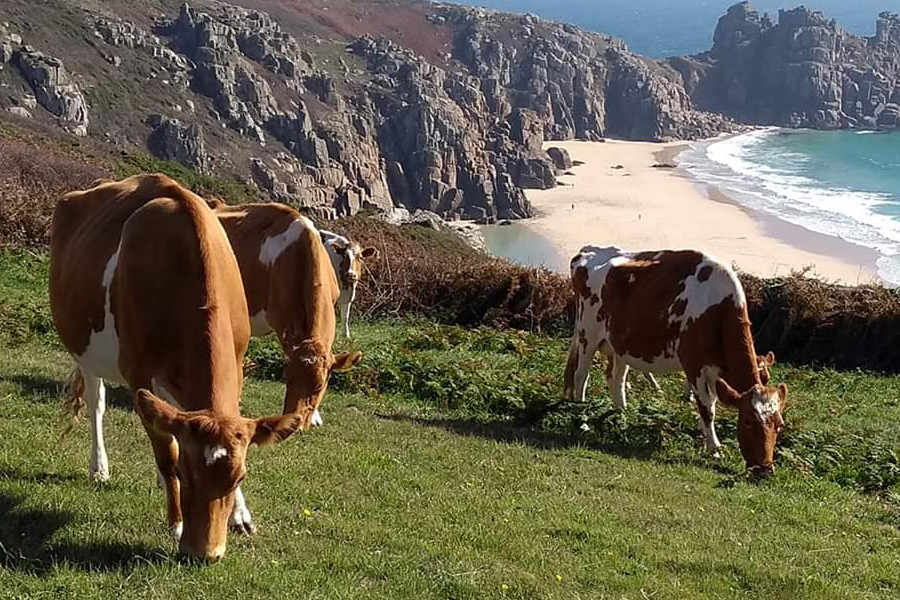
Cornish cheese is so highly regarded because of the quality of the grazing. Cornwall has an especially temperate climate which extends the grass growing season. The abundance of grass means that cows produce milk with the highest percentage butterfat content in England and Wales (an average 4.33% compared with 4.1%). A high level of carotene is also found in the grass which contributions to its rich buttery colour. Added to this is the diverse range of grasses and herbs that many of the herd graze on - all contributing to the rich creamy milk that goes in to making the cheeses.
We’ve picked out some of our favourite cheeses to tell your more about. These cheeses all come from fantastic artisan producers, so you know you'll be getting the highest quality produce.
Whalesborough Cheese is based in Marhamchurch near Bude, Sue Proudfoot and her family have been winning awards for their small-batch cheeses for almost a quarter-century. Best-sellers include traditional Cornish farmhouse cheese Trelawny and Miss Muffet, a continental-style washed curd cheese with a nutty, creamy flavour – both boast a pink/grey natural mould rind, unique to the Whalesborough maturing room. You will smell Keltic Gold coming – this washed rind cheese is dipped thrice weekly in local cider for a full, sweet flavour, and is so pungent it has its own maturing room. All three have been showered with praise, from the Great Taste Awards to the Nantwich International Cheese Show.
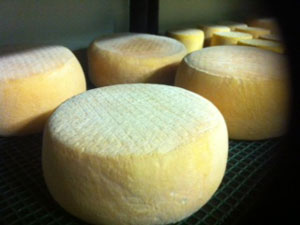
The first blue cheese to be made in Cornwall, this award-winner was created as a new revenue stream for Phillip and Carol Stansfield, who had identified a gap in the market for a British-made blue cheese milder than the existing corkers on the market. Their hunch was correct: Cornish Blue was named World Champion Cheese, 2010. Cornish Blue is a creamy, blue-veined cheese made from cow's milk. It is similar in style to classic European blues but with a distinct Cornish character. This cheese is rich, buttery, and has a well-balanced blue flavor that is both creamy and tangy. The Liskeard dairy now produces a goat’s milk alternative (Cornish Nanny) and recently branched out into Brie.
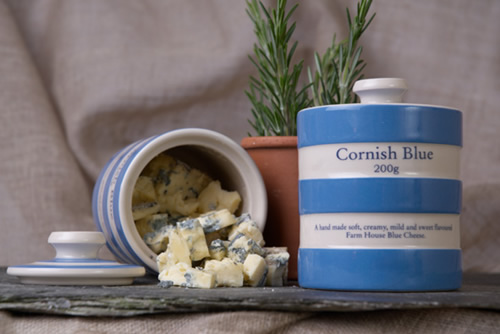
Cornish Gouda is an authentic Dutch cheese, made in Lanreath. You read that right - the Spierings family moved from the Netherlands to Cornwall in 1998 and started a small dairy farm, but almost shut up shop in 2012 due to poor milk prices. Youngest son Giel pledged to make the farm viable by diversifying into cheese production, using traditional Gouda techniques. Now parents Joost and Annemarie farm, Giel makes the cheese and brother Jan manages the crops to feed their pedigree herd. Choose from semi-mature, mature and extra-mature varieties, as well as flavourings including fenugreek. Cornish Gouda is smooth, buttery, and slightly sweet, with a nutty flavour.
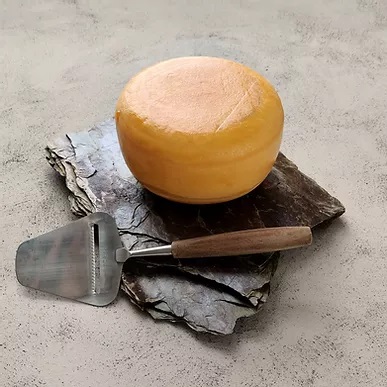
This small dairy in Ponsanooth has some cheeses of impressive pedigree in its stable. Distinctive nettle-wrapped Yarg was first produced in the 1980s when Bodmin Moor farmer Alan Gray found a 17th-century recipe in his attic and named it after himself (spell it backwards!). It now comes in original Cornish and Wild Garlic varieties. Cornish Yarg is a semi-hard, cow's milk cheese known for its unique appearance. When wrapped in nettles they impart a slightly earthy, mushroom-like flavor and a striking green and white rind. The interior of Cornish Yarg is creamy and mild, with a slightly crumbly texture and a gentle tang.

Kern, meanwhile, means “round” in Kernewek (Cornish); this mature farmhouse cheese achieved global superstar status when it won Supreme Champion at the World Cheese Awards in 2017. Cornish Kern is a hard cheese made using raw cow's milk. It is carefully matured for a minimum of 16 months to develop its intense flavor. This cheese is robust and complex, with a nutty and caramelized undertone, making it a delightful choice for cheese connoisseurs.All are handmade by Catherine Mead and her team, using creamy Ayrshire milk.
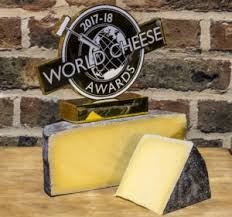
Curds & Croust Martin Gaylard in East Taphouse has been making soft cheeses since he was in short trousers, and knows from experience that the secret lies in using the best ingredients to produce a really good curd. He takes inspiration from across the Channel: Miss Wenna is a mellow Cornish Brie, Boy Laity a rich, bold Camembert. We also stock Nanny Florrie, a decadent, sweet and nutty soft goat’s cheese. As for the name: Curd is self-explanatory, but did you know Croust is a Cornish term for a simple tasty snack mid-morning or afternoon?
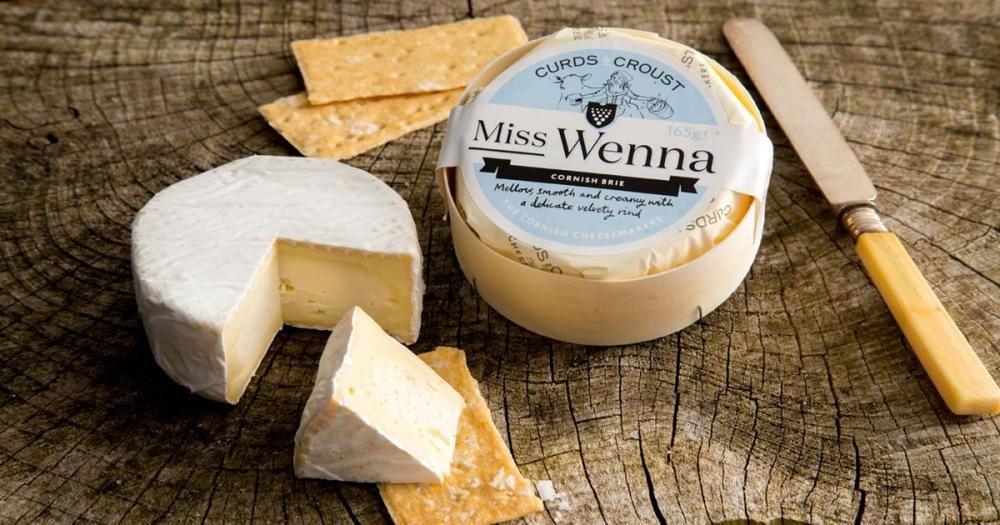
Our foodie gift hampers are the perfect present to send for those hard to buy for people. If they are a real cheese lover, our Cheese Hampers will go down a treat. They are the perfect gift to send for Christmas, birthdays, or for any celebration.
The Cornish Cheese Board Hamper is a great gift to send that will definitely be appreciated by the recipient. Containing 5 Cornish cheeses plus all the crackers and chutneys needed, it is the ideal present for birthdays, to say Thank You, and a great gift to send to dad for Fathers Day.
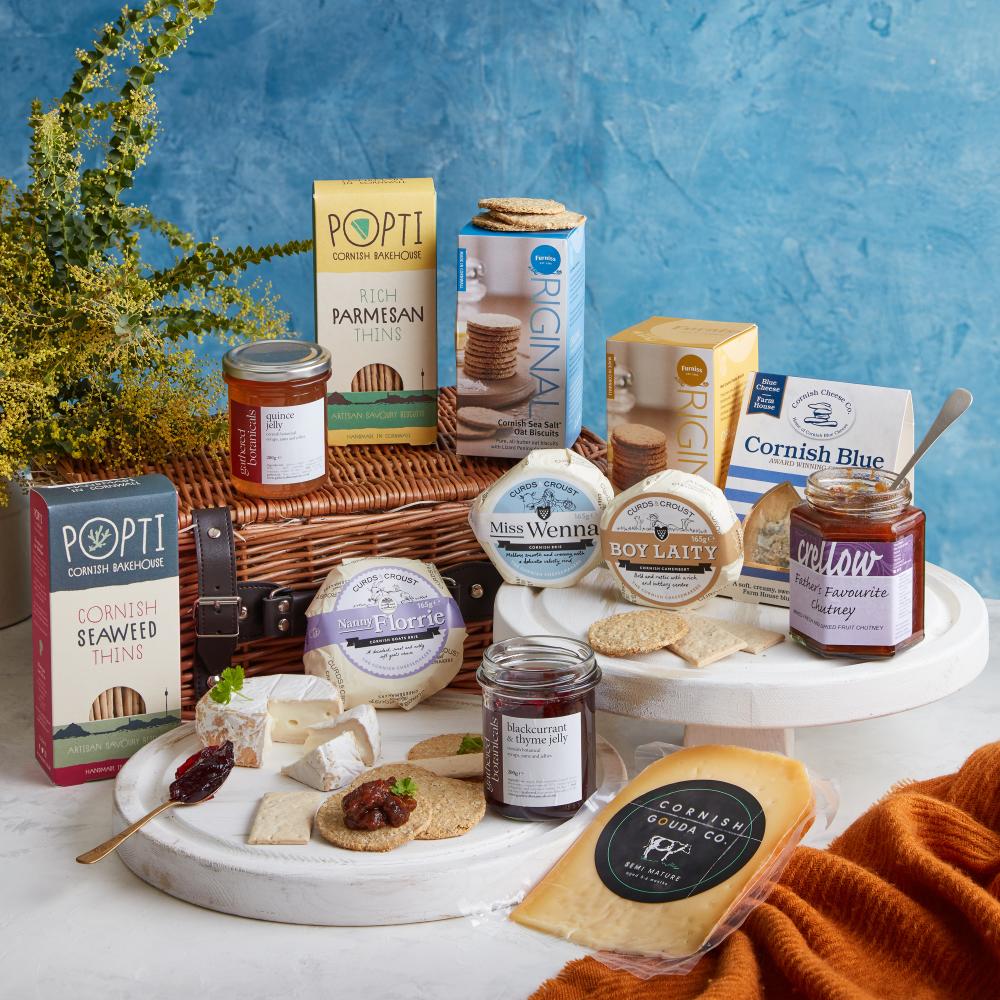
If you are looking to send a present to share then our Cheese & Charcuterie Hamper makes a delicious and luxurious gift. Combining artisan cheeses with the finest cured meats and all the accompaniments you’ll need, this hamper for foodies is fantastic value.
All our hampers include free UK delivery and handwritten greetings cards.
Posted in Produce & Products
Cornish lobsters are mainly caught in rocky areas and on the edges of rocky reefs around the Cornish coast. They are traditionally caught in pots which are set out in lines on the seabed and then hauled in by small boats from harbours dotted along the coast. Traditional inkwell pots were originally constructed from willow withy’s but nowadays pots are constructed from steel and nylon net with plastic fittings. All are baited traps that allow crabs in but prevent them from easily escaping. Pots are dropped down to the seabed and are left for several hours or days before being retrieved. Any undersized crustaceans can be returned unharmed and in Cornwall there is little impact on the seabed on which the pots are deployed.
Conservation efforts mean stocks of lobsters are healthy and it has a sustainability rating by the Cornwall Good Seafood Guide of 3 due to the good stock management, low impact fishing method and ongoing conservation efforts of the Cornish fishing community.
Preparing a cooked lobster can seem intimidating, but with a few simple steps, you can enjoy this delicious seafood delicacy at home. Follow our guide to make the process easy and enjoyable.
Ingredients and Tools You'll Need:
Fresh cooked lobster
Sharp chef’s knife or kitchen shears
Cutting board
Kitchen towel
Small bowl (for the lobster meat)
Nutcracker or lobster crackers
Seafood forks or picks
Step-by-Step Instructions:
Firstly, prepare your work area. Lay out a large cutting board on a stable surface.
Have a sharp knife or kitchen shears ready, along with a kitchen towel to keep the lobster steady.
Place a small bowl nearby to collect the lobster meat.
!: Remove the Claws:
Hold the lobster securely with the kitchen towel.
Twist off the claws at the point where they join the body. This might require a bit of force.
2: Crack Open the Claws:
Use a nutcracker or lobster crackers to gently crack the shell of each claw and knuckle.
Carefully extract the meat using seafood forks or picks, and place it in the bowl.
3: Separate the Tail:
With the lobster on its back, hold the body with one hand and the tail with the other.
Twist and pull the tail away from the body until it detaches.
4: Extract Tail Meat:
Press down on the sides of the tail to crack the shell.
Split the shell open with your hands or kitchen shears.
Pull out the tail meat in one piece and remove the dark vein that runs down the center.
5: Remove and Clean the Legs:
Break off the smaller legs from the body.
You can extract the meat by rolling a rolling pin over the legs to push the meat out.
6: Serve and Enjoy:
Arrange the lobster meat on a serving platter.
Pair with melted butter, lemon wedges, and your favorite side dishes for a delightful meal.
Preparing a cooked lobster is easier than it looks. By following these steps, you'll be able to enjoy a luxurious seafood dish that's perfect for special occasions or a gourmet treat at home. Bon appétit!
Looking for great recipes for Cornish lobster?
Posted in Produce & Products and Fish & Seafood Recipes
Beetroot, once a staple of 1970s British salads, often cooked and pickled in vinegar, is a root vegetable characterized by its dark purple skin and vibrant pink or purple flesh. In recent years, beetroot has experienced a well-deserved resurgence in popularity, owing to its earthy, rich, and sweet flavor profile, as well as its striking color, which lends itself beautifully to both sweet and savory culinary creations. Not all beetroot are round and purple. They also come in yellow (it doesn't stain so great if that puts you off!), pink and white striped which looks wonderful in a carpaccio, and in cylindrical forms.
Beetroot shares botanical kinship with spinach and chard and has a whole host of health benefits.
Top 10 Health Benefits of Beetroot:
How to cook, prepare, and store your beets
To cook beetroot whole, begin by washing it without peeling. Trim the stalks to 2.5cm and leave the root intact; excessive trimming may cause the beetroot to bleed color. It can be baked in a low oven for 2-3 hours, either wrapped in foil or placed in a lidded casserole dish with a little water. Alternatively, it can be simmered for about an hour after the same initial preparation.
Beetroot can also be enjoyed raw, peeled, and grated into salads and slaws or thinly shaved for a 'carpaccio' effect. The leaves can be washed and trimmed for use in salads or as a garnish.
Cooking Suggestions for Beetroot:
Roast beetroot and toss with walnut oil and chives, or bake it with olive oil and cumin seeds before adding feta and baking again. Boiling beetroot for a few minutes, draining, and serving with a drizzle of olive oil or butter is another option. Raw beetroot can also be juiced and mixed with carrot juice for a refreshing and vitamin-rich beverage.
Storage Recommendations for Beetroot:
Fresh beetroot can be stored for several weeks in a cool, dark place. Vacuum-packed cooked beetroot is also available, ideal for pickling, roasting, or adding to salads, and can be refrigerated for several months.
Posted in Produce & Products
Eating beef has got a bad press in recent years due to concerns over environmental impacts, welfare standards, and health concerns. However not all beef production around the world is the same. In the UK cattle being raised for beef are grazed which means we have extensive pasture areas that provide habitats for wildlife, and when actively managed are very effective in taking carbon dioxide from the atmosphere and storing it. This method of raising cattle means the meat produced is a rich source of essential nutrients that can be hard to get from other sources. In addition the UK has some of the highest standards in welfare ranking in the top 3 in the Animal Protection Index.
The UK's beef industry has an international reputation for quality and is renown for its rich heritage. Here in Cornwall we have fantastic prime beef production with much of it supplied to top restaurants both within Cornwall and across the UK. The long grass growing season combined with the traditional breeds used for beef farming results in a superb quality meat. Our beef at the Cornish Food Box Company is selected and prepared by the highly regarded James Kittow's Butchers of Kilhallon for all our orders.
What impact does beef farming have on greenhouse gas emissions?
Agriculture as a whole makes up 10% of greenhouse gas emissions in the UK with cattle & sheep farming accounting for about 5.7% of the total; far behind the impacts of transport, energy supply and business use. Sequestration in pastures also takes carbon out of the atmosphere meaning all livestock grazing only contributes 4.9% of UK emissions. The UK method of raising cattle on extensive grasslands means greenhouse gas emissions from beef produced in the UK is about half the global average.
Is beef farming bad for the environment?
Central to the superiority of British beef is the emphasis on grass-fed diets for cattle. The landscapes of the UK offer a bounty of nutrient-rich grasses, which form the primary source of sustenance for grazing livestock. This natural diet not only enhances the flavour profile of the meat but also contributes to its superior texture and marbling. Around 70% of a typical British beef cattles' diet is made up of grass with grains only contributing around 5%.
In some areas livestock grazing is critical to the lifecycle of wildlife. For instance both the Large Blue Butterfly and the Chough depend on livestock grazing to maintain the open habitats they depend on. Regenerative farming with the introduction of herbal lays, mob grazing, and use of livestock in arable crop rotations all contribute to soil health and fertility with the very best livestock farms actually storing more carbon than they produce.
In terms of water usage only 0.4% of the water used to rear beef cattle is from the tap. 84.4% of the water used is rainfall on to grasslands to grow grass - so essentially unavailable for other uses. Many farmers are taking measures to mitigate the impacts of cattle manure, and use of technologies such as anerobic digestion contributes to producing renewable energy to power homes.
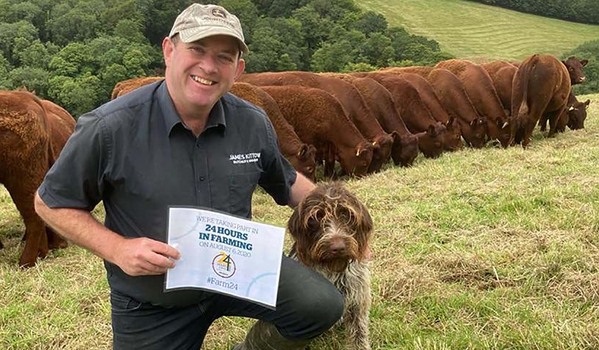
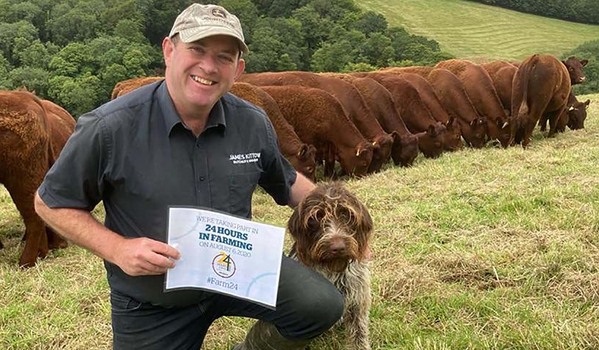
Is eating beef bad for your health?
Red meat is a significant source of protein as well as being one of the richest sources of essential nutrients such as vitamin B12, vitamin D, potassium, selenium, zinc and iron. The nutrients in red meat are far more bioavailable than many other food sources, and eating red meat can help your body absorb these important minerals. Red meat is naturaly low in salt and of course as a natural product does not contain the ultra processed ingredients contained in many meat substitute products.
Isn't beef full of hormones & antibiotics?
In an age where consumers prioritise sustainability and ethical sourcing, British beef sets the standard for traceability and transparency. Rigorous traceability systems track each animal from farm to fork, ensuring full accountability at every stage of the supply chain. This level of transparency underscores the commitment of British farmers to responsible practices.
The UK is the fifth lowest user of antibiotics on the farm across 31 European countries and antibiotic use has reduced by 52% since 2014. Only the Nordic countries do better and that is primarily due to their dry, cold climate which means the antibiotic need is lower. Antibiotic use is strictly controlled and only used where necessary for animal welfare. There are strict withdrawal periods for all medicines which means the meat can only enter the food chain when safe to do so.
Using growth promoters including hormones and low dose antibiotics is banned in the UK. In many countries around the world the use of hormones and low dose antibiotics is commonplace to increase animal growth rates. Making sure that your beef is truly British is the best way to ensure your beef is hormone and antibiotic free.
What about animal welfare?
British beef boasts a legacy rooted in centuries of tradition and meticulous breeding practices. Central to the ethos of British beef production is the welfare of the animals themselves. Stringent regulations govern every aspect of cattle rearing, from housing conditions to transportation methods. British farmers prioritise the well-being of their livestock, providing spacious living environments, access to clean water, and veterinary care when needed. This emphasis on animal welfare not only aligns with ethical principles but also contributes to the superior quality of the meat.
We have lots of recipes, cooking tips and more for you to make the best of your beef.
From how to cook the best steak, roasting joint cooking times, beef pairings and more see our Beef Recipe Page.
Posted in Produce & Products
This winter has been one of the wettest in decades in the UK. It follows a blistering hot summer and warm autumn which caused their own problems for farmers. In many areas of the country farms are flooded and even in areas which aren't actually under water, the ground is sodden and has been impossible to prepare, plant, fertilise or harvest crops as usual.
What has the impact of this been on our farmers and vegetable crops?
It has been reported that around 25% less crops have been planted than usual in the UK this winter season. This has been due to a multitude of factors but primarily the wet weather meaning fields have been flooded or too wet to work. The wet autumn meant a lot of crops in ground were ruined - carrots, parsnips and other winter root crops have rotted in ground as they were unable to be lifted from waterlogged soils. For those crops that have been harvested both the yield and quality have been much lower than usual. Crops have often been left too long in wet soils as farmers were unable to get harvesting equipment on to their fields. In addition the poor growing conditions and low light levels through out the autumn and winter has meant crops simply haven't grown as well as usual.
This has led to poor harvests across the UK and shortages for some vegetables the UK specialises in such as cauliflowers and potatoes. One of the main wholesalers in Cornwall had several weeks where they were unable to get hold of any cauliflower in the UK and were having to import them from Europe at £2 per head! Reports are that imported cauliflower have been regularly at 3 times the usual price this winter.
Potatoes are one of the UK's main vegetable crops and is one of the worst affected crops. This season has resulted in the lowest potato crop ever recorded in the UK. Here in Cornwall potato growing is a mainstay for many vegetable farmers. The wet weather means potatoes have been left to rot in the ground, and those that have been lifted are of lower quality and haven't stored as well as usual.
Shortages of seed and rising seed prices have also impacted the planting this spring. Many growers are saying they simply can't get hold of the seeds they need. Our smaller organic growers are particularly struggling to get hold of the seeds they need which has meant high costs and less crops in the ground for the coming year.
To read more on how the weather is impact farming and vegetable growers in the UK:
Fruitnet.com - Extreme weather taking it's toll on vegetables
https://www.fwi.co.uk/arable/further-wet-weather-raises-fears-of-harvest-catastrophe
Posted in Produce & Products
Selecting Fresh Whiting: When purchasing whiting, look for fish that has bright, clear eyes, firm flesh, and a fresh, ocean-like scent. At The Cornish Food Box Company, we offer high-quality, sustainably sourced whiting that is perfect for all your culinary adventures.
Cleaning the Fish: Rinse the whiting under cold water and pat dry with paper towels. Remove any scales, if present, by scraping them off with a knife or fish scaler. Trim off any fins and use kitchen shears to snip off the dorsal fin, if desired.
Removing the Innards: Make a small incision along the belly of the whiting and carefully remove the innards, being sure to discard them properly. Rinse the cavity thoroughly under cold water to remove any remaining traces of blood or debris.
Optional: Filleting the Fish: If you prefer boneless fillets, you can fillet the whiting by making a cut behind the head and along the backbone, then carefully removing the fillets with a sharp knife. Alternatively, you can leave the whiting whole for a more traditional presentation.
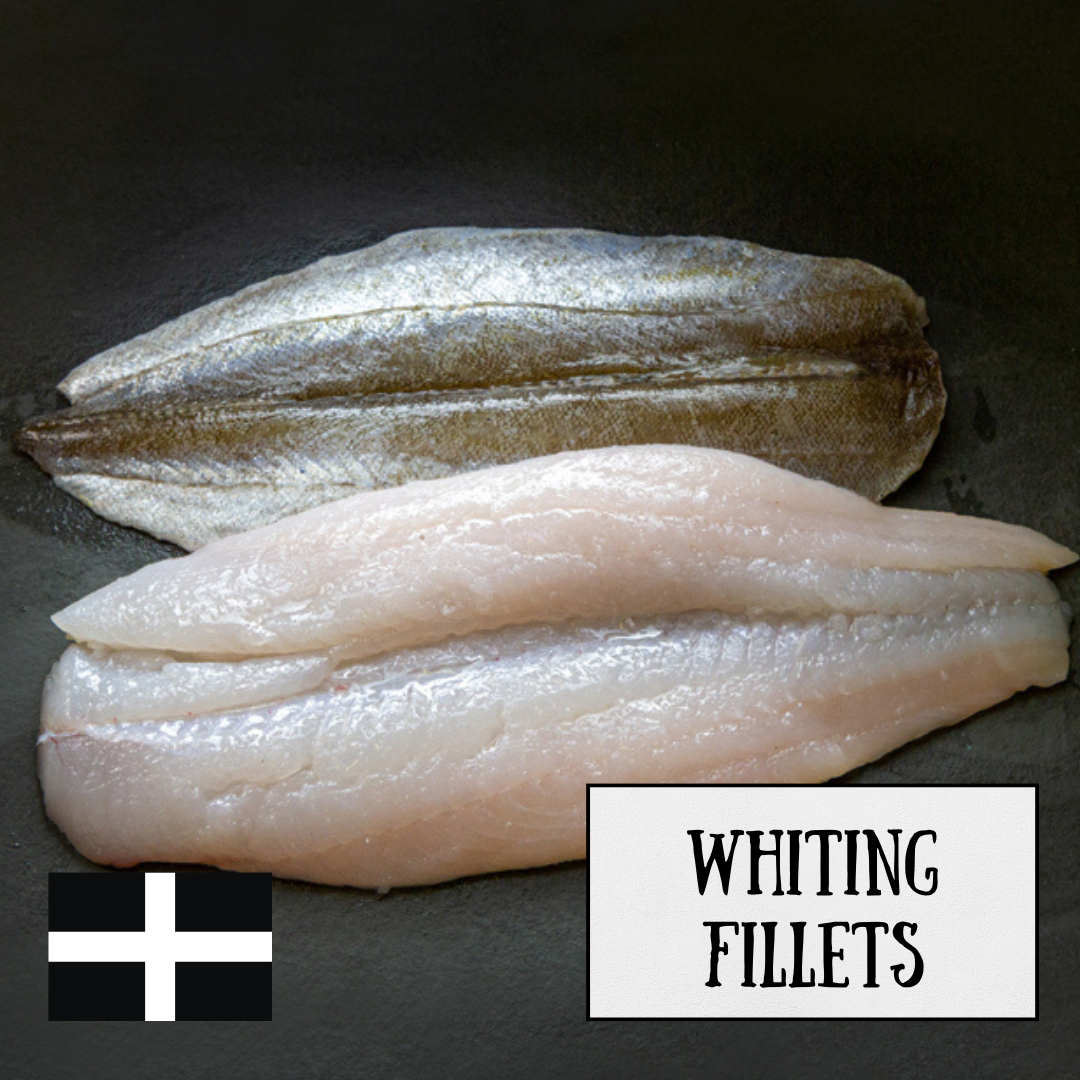

Simple Pan-Frying: One of the easiest and most delicious ways to cook whiting is by pan-frying it. Season the whiting fillets with salt, pepper, and your favourite herbs or spices. Heat a skillet over medium-high heat and add a splash of oil or butter. Once hot, add the whiting fillets to the skillet and cook for 2-3 minutes on each side until golden brown and cooked through.
Baking in the Oven: Preheat your oven to 200°C (400°F). Place the seasoned whiting fillets on a baking tray lined with parchment paper. Drizzle with olive oil and a squeeze of lemon juice, then bake for 12-15 minutes until the fish is opaque and flakes easily with a fork.
Grilling: Fire up the grill to medium-high heat. Season the whiting fillets as desired and place them directly on the grill grates. Cook for 3-4 minutes on each side, or until grill marks form and the fish is cooked through.
Steaming: For a healthier cooking method, try steaming the whiting fillets. Season the fish and place it in a steamer basket over simmering water. Cover and steam for 6-8 minutes, or until the fish is opaque and flakes easily.
Serving Suggestions
Serve pan-fried whiting fillets with a squeeze of lemon juice and a side of roasted vegetables for a simple and nutritious meal.
Pair baked whiting fillets with a fresh salad or steamed greens for a light and satisfying lunch or dinner.
Enjoy grilled whiting fillets with a tangy salsa or homemade tartar sauce for a burst of flavour.
With these simple tips and techniques, you can easily prepare and cook whiting to perfection. Whether you prefer it pan-fried, baked, grilled, or steamed, whiting is a delicious and healthy addition to any meal.
Posted in Produce & Products and Fish & Seafood Recipes
In an era marked by environmental concerns and calls for action against climate change, it's becoming increasingly clear that our food choices play a significant role in shaping the future of our planet. Net Zero Food is a concept aimed at reducing the carbon footprint of our food consumption and making our food shopping more sustainable. Food production accounts for around 34% of global greenhouse emissions and has major impacts on land use, water resources, and our health. From deforestation and land degradation to intensive agriculture and food waste, the environmental impacts of our food choices are vast and far-reaching. As a consumer it can sometimes be difficult to know what the right thing to do is. Should we all be eating entirely plant based diets? How do you know if that tuna really is dolphin friendly? Does going green in the UK mean living on cabbages and swede year round?
At its core, net zero food refers to the idea of balancing the emissions produced by food production and consumption with measures to offset or mitigate those emissions. This involves reducing greenhouse gas emissions throughout the food supply chain, from farm to fork, and implementing practices that promote environmental sustainability and resilience. This can take various forms from regenerative farming techniques where beef cattle are fed entirely on herbal lays and carbon is laid down in the soils to ensuring that the food retail system operates in a way that doesn't create food waste.
The food system is a major contributor to greenhouse gas emissions, accounting for around 34% of global emissions. By adopting net zero food principles, we can help reduce our carbon footprint and mitigate the effects of climate change on our planet.
As individuals, we have the power to make a real difference through our food choices. By embracing the principles of net zero food and making sustainable shopping habits part of our daily lives, we can contribute to a more resilient and regenerative food system for future generations.
Net zero food offers a pathway towards a more sustainable and resilient food future. By making conscious choices about what we eat and how we shop, we can reduce our carbon footprint, support local communities, and protect the planet for generations to come. Let's commit to making our food shopping more sustainable and embrace the power of net zero food for a brighter, greener future.


1: Buy Local and Seasonal: Opting for locally grown and seasonal produce can significantly reduce the emissions associated with food transportation and storage. Food grown without the need for additional inputs such as irrigation, light and heat have a much lower impact. The best way to know where your food is coming from is to buy from a local company you can trust, and choose to eat seasonal produce where possible.
2: Minimise Food Waste: Food waste is a major contributor to greenhouse gas emissions. Plan meals carefully, store food properly, and use leftovers creatively to minimise waste. Composting organic waste can also help reduce methane emissions from landfills. Many local coucnils now collect food waste from households or there are great composters on the market.
3: Support Sustainable Agriculture: Know where you food is coming from and how it was produced. Traceability and transparency on food production can be really difficult when you are buying from large companies dealing with complex supply chains. By buying locally from businesses you can trustis the best way of knowing how your food has been produced. Certification schemes such as rainforest alliance, fairtrade or labeling such as organic can also help you understand how sustainable your food choices are.
4: Reduce Packaging Waste: Choose products with minimal packaging or opt for eco-friendly packaging options such as recyclable or compostable materials. When buying food gifts choose suppliers that minimise packaging, use plastic free alternatives, and support sustainable producers.
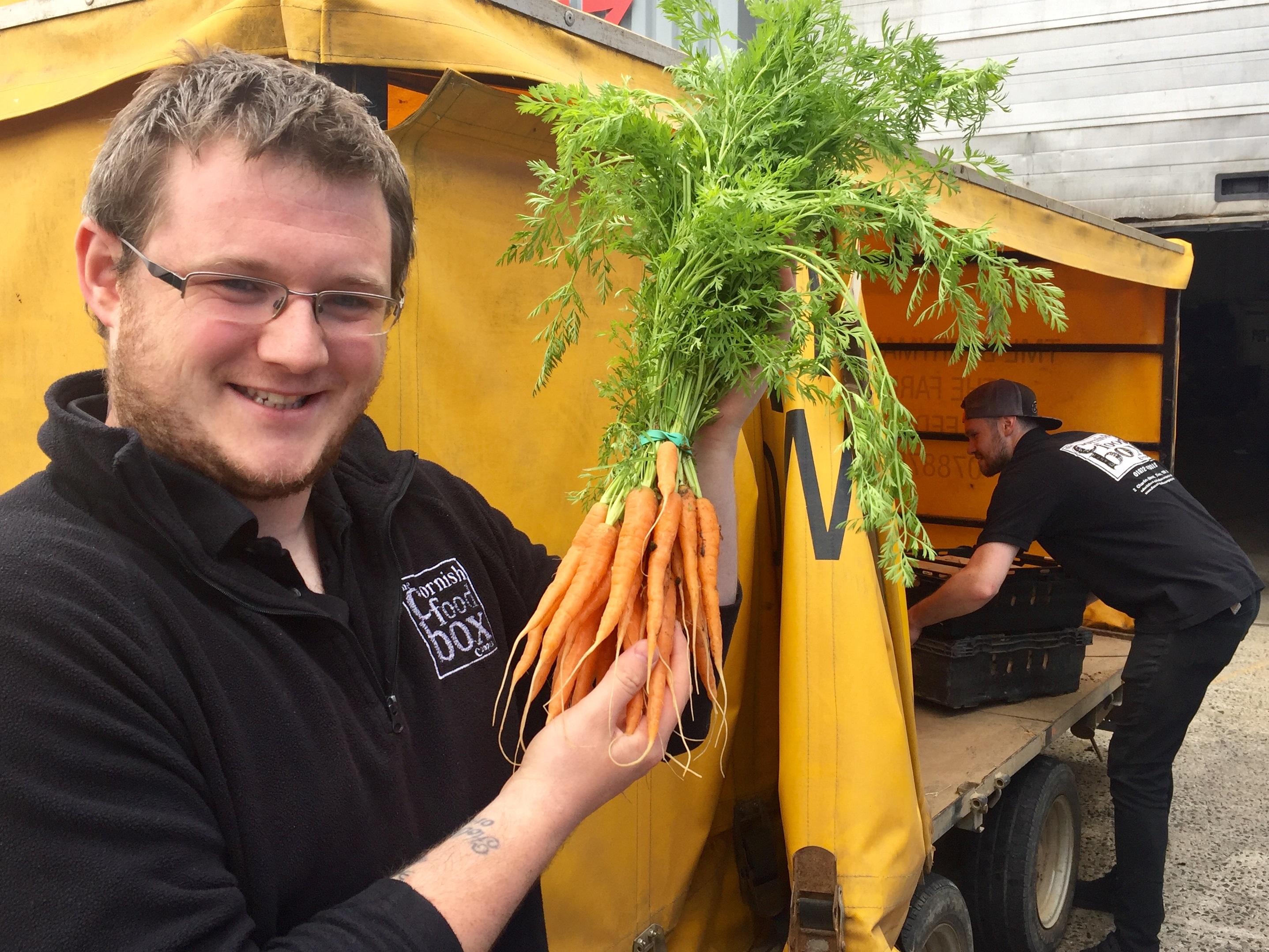

You can get the taste of Cornwall for yourself by getting a fresh food delivery to your door. By getting your fresh food delivered from Cornish Food Box Company, you're getting it straight from the source, guaranteeing freshness and quality as well as supporting local fishermen, farmers, and a whole community of food producers and contributing to the livelihoods of our rural communities.
With our online ordering and nationwide delivery options, getting your food delivered is convenient and hassle-free, allowing you to enjoy the best of food produced in Cornwall whilst supporting a more sustainable food system that's good for farmers, animal welfare, your health and the environment.
Posted in Produce & Products
Cornwall, with its rugged coastline and abundant clear waters stretching out into the Atlantic Ocean, boasts a rich bounty of fish and seafood that has been a cornerstone of its culinary heritage for centuries. The Cornish fishing industry is a vital part of the region's cultural heritage and economic vitality. There is a proud tradition of small-scale, family-run fishing operations that have sustained coastal communities for generations. Fishing has long been a way of life in Cornwall, with fishermen venturing out to sea in search of a bountiful harvest of fish and seafood to support their families and livelihoods.
Throughout Cornwall, picturesque harbours and fishing villages dot the coastline, serving as the beating heart of the local fishing industry. Harbours such as Padstow, Porthleven, Looe and St. Ives still support local fishing boats who regularly land their catches. Newlyn, which has been a working harbour since the 15th century is one of the UK’s largest fishing ports and is known for its bustling fish market, where fishermen unload their catch early each morning to be sold to local and national buyers.


Cornish fishermen employ a variety of fishing methods to harvest the rich bounty of fish and seafood found in local waters. Some of the most common methods include:
Trawling: Trawling involves dragging a net through the water to catch fish. In Cornwall, both bottom trawling and midwater trawling are used, depending on the target species and fishing grounds.
Potting: Potting, or using lobster pots and crab pots, is a traditional method of catching shellfish like crab and lobster. The pots are baited and left on the seabed for a period of time before being hauled up to retrieve the catch. This is a highly sustainable way of fishing with only the target species caught and undersized individuals let go unharmed.
Netting: Netting, including gillnetting and seine netting, is another common fishing method used in Cornwall. Nets are used to surround fish or form a barrier to catch them as they swim.
For more information on the types of fishing methods used in Cornwall visit Cornwall Good Seafood Guide.
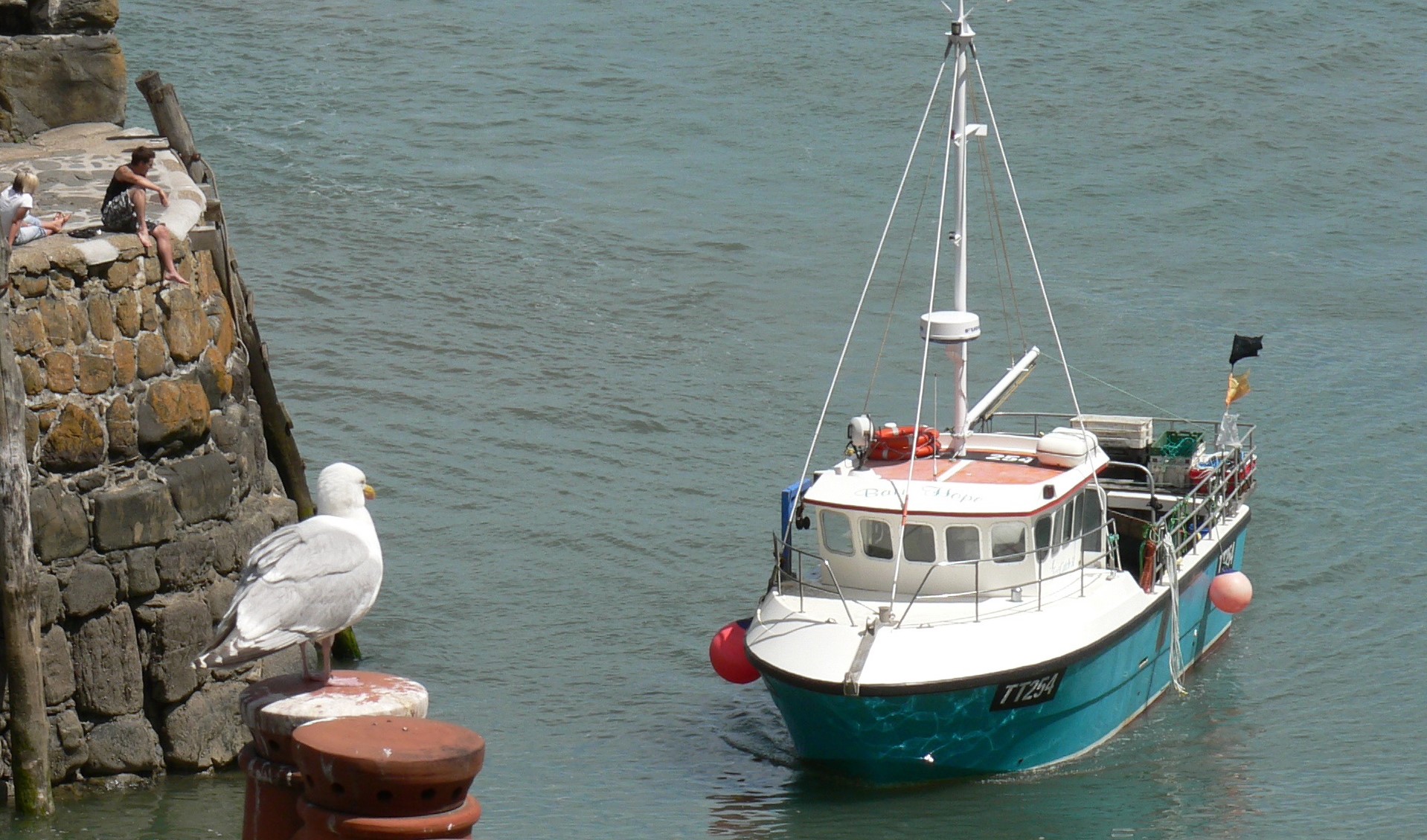

So why is Cornish Fish & Seafood so highly regarded?
There are several reasons why fish and seafood from Cornwall are considered some of the best in the world. Our rugged coastline stretches out in to the Atlantic and Grade A clear waters means we have access to some of the best fishing grounds in the UK.
The diverse range of habitats that surround the coastline of Cornwall provide homes for a wide range of fish and seafood from Atlantic Bluefin Tuna to Turbot. The small harbours scattered along the coastline supports our small inshore fleet as well as the larger boats operating out of larger harbours such as Newlyn.
The small day boats land fish within a few hours of being caught and often use far more sustainable methods than the larger trawlers. This results in the freshest quality fish available, caught in the most sustainable ways to protect fish stocks for the future.
Cornish fishermen take pride in their craft and adhere to strict fishing regulations to protect fish stocks and maintain sustainable practices. This commitment to quality ensures that Cornish fish and seafood are of the highest standard.
At The Cornish Food Box Company we carefully consider which species to stock and how the fish has been caught. By working closely with our fishmongers we have a great range of carefully sourced and prepared fish & seafood which is amongst the most sustainable & freshest you can buy.
Main Fish & Seafood Species Landed in Cornwall
Mackerel: Known for its rich, oily flesh and distinctive flavour, mackerel is a prized catch in Cornish waters. It's commonly grilled, smoked, or pan-fried and is a favourite among seafood lovers for its versatility and delicious taste.
Haddock: With its firm, white flesh and mild flavour, haddock is another popular species caught off the coast of Cornwall. It's often used in traditional British dishes like fish and chips or baked haddock with a breadcrumb topping.
Cod: Cod is one of the most iconic species of fish found in Cornish waters. It has a flaky texture and a mild, slightly sweet flavour, making it a versatile ingredient in a wide range of dishes, from fish pies to fish tacos.
Brown Crab: Cornwall is famous for its succulent, sweet crab meat, harvested from the abundant crab populations found along its coastline. Whether served cold in a salad or hot in a crab linguine, Cornish crab is a true delicacy.
Lobster: Cornish lobster is prized for its firm, succulent meat and rich, sweet flavour. It's often boiled or grilled and served with melted butter or garlic mayonnaise for a truly indulgent seafood experience.
Whiting: Whiting is a species of white fish commonly found in the waters off the coast of Cornwall. It has delicate, flaky flesh and a mild, slightly sweet flavour, making it a versatile option for cooking. Whiting is often used in traditional recipes such as fish pies, fish cakes, and battered fish fillets.
Hake: Hake is a popular fish species found in the North Atlantic Ocean, including the waters around Cornwall. It has firm, white flesh and a mild, sweet flavour, similar to cod or haddock. Hake is prized for its versatility in cooking and is commonly used in dishes such as fish stews, grilled fillets, and baked casseroles.
Squid: Squid, also known as calamari, is a cephalopod mollusk commonly found in the waters off the coast of Cornwall. It has tender, chewy flesh and a mild, slightly sweet flavour. Squid is often prepared by grilling, frying, or sautéing and is a popular ingredient in Mediterranean and Asian cuisines.
Gurnard: Gurnard is a family of fish species commonly found in the waters around Cornwall, including the red gurnard and grey gurnard. It has firm, white flesh and a sweet, nutty flavour. Gurnard is often used in seafood soups, stews, and curries, and its distinctive appearance makes it a favourite among seafood enthusiasts.
Monkfish: Monkfish, also known as anglerfish or lotte, is a unique-looking fish species found in the North Atlantic Ocean, including the waters off the coast of Cornwall. It has firm, dense flesh and a sweet, mild flavour reminiscent of lobster. Monkfish is often compared to lobster or scallops in taste and is prized for its versatility in cooking, from pan-searing to roasting to grilling.
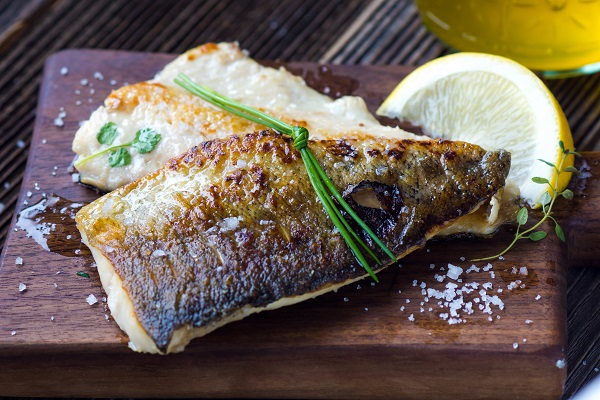

Why not experience the taste of Cornwall for yourself by getting fish and seafood delivered straight to your doorstep? By getting fish and seafood delivered from Cornwall, you're getting it straight from the source, guaranteeing freshness and quality as well as supporting local fishmongers and fishermen and contributing to the livelihoods of coastal communities and helping to sustain traditional fishing practices.
With our online ordering and nationwide delivery options, getting fish and seafood delivered from Cornwall is convenient and hassle-free, allowing you to enjoy the best of Cornish catch without leaving your home. If you would like to order some Cornish & Seafood for delivery to your door click here.
Posted in Produce & Products